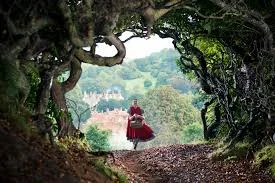December 30, 2014
There’s a fine, thoughtful movie about the meaning of freedom in theaters now, and it’s not “Exodus: Gods and Kings.” It’s “Into the Woods,” the new cinematic version of the Sondheim musical.
“Into the Woods” intertwines several classic fairy tales: Cinderella, Rapunzel, Jack & the Beanstalk, and Little Red Riding Hood all merge together in Act 1, along with a Baker & His Wife and a witch who manipulates the plot in order to undo a curse that was placed on her. There are vengeful giants, a big bad wolf, and two Prince Charmings who are as shallow as you always imagined they would be. All of the characters discover that fate has sent them “into the woods” – a psychosexual place of innocence-shedding (although not as sexualized as I remember the play being when I saw it on Broadway years ago).
There is a lot going on in those dark woods. The show’s themes include: moral development, community vs. the individual, parenting, leaving home, spoiled teens, infidelity (Prince: “I was raised to be charming, not sincere!”), friendship, sacrifice, and fate. But there are two Torah themes in the story that particularly resonate with me.
The first is the show’s wonderful two-act structure (especially poignant on stage, where there is an intermission between parts). Act 1 braids together the well-known fairy tales, and it climaxes exactly the way that every fairy tale does: They all live happily ever after.
The beauty of “Into the Woods” is: There’s an Act 2.
In other words, what happens after “happily ever after”? Cinderella discovers she isn’t cut out for the life of a princess. The baker discovers that the baby he yearned for isn’t so easy to care for. Several characters die before their time. In other words, there is no “happily ever after”—because there remains work to do and lives to live and there are still giants (who are threatening everyone’s survival) to slay.
“Happily ever after” is for fairy tales. Life isn’t a fairy tale—and neither is the Torah. The entire saga of the Torah – from the expulsion from Eden, the descent to Egypt, and the sojourns in the desert – can be seen as a quest towards reaching (returning to) the Promised Land. Four and a half of its five books take place along that road. At the culmination of Deuteronomy, the Israelites stand on the edge of the Land, and Moses goes up to Mt. Nebo and surveys all of it. And in shul on Simchat Torah, we read the final words of the Torah – never again did there arise a prophet like Moses – and then… “In the beginning G-d created the heavens and the earth.” The cycle of reading starts over again, and we never quite get to the Promised Land. Why not? Because there is still work to do. The best we can do is move a little closer towards that goal, and set up the next generation to be that much closer to the Promised Land of the future.
“Into the Woods” is also about freedom. When Act 2 opens, the characters are free agents, having fulfilled their dreams and desires. Then fate intervenes. A wrathful giant wants to demolish the kingdom, the survivors have to decide: give up Jack (of beanstalk fame) or stand united. There is a temptation to offer him as a sacrifice for the sake of the greater good. There is a lot of self-doubt, the presumption being that only princes are qualified to do battle with the forces of evil. (This recalls a great liberal falsehood: That because we’re not perfect, we’re not qualified to make moral arguments against evil.)
Jewish tradition makes a similar argument about freedom. Pirkei Avot 6:2 quotes the Torah, The tablets were the handiwork of G-d, with G-d’s writing engraved on the tablets. Then it creatively says: Don’t read “engraved [charut] on the tablets” but rather “freedom [chayrut] was on the tablets.” It may be counterintuitive to say that subscribing to a life of religious prescriptions and service to G-d and others is a life of freedom, but that’s precisely our tradition’s claim.
What is freedom? It doesn’t mean just doing whatever you want. That’s not freedom; that’s anarchy, irresponsibility, frivolousness. In Jewish spiritual thought, freedom means encountering your own unique destiny and seizing the responsibility that has been uniquely given to you. Not running away, but sharing the responsibility that fate and history placed before you.
The protagonists in “Into the Woods” discover that nuanced understanding of what it means to be free. They come to learn that by working together, they can halt giants in their tracks and even eke out a hopeful future—even if it’s not exactly going to be “happily ever after.”
